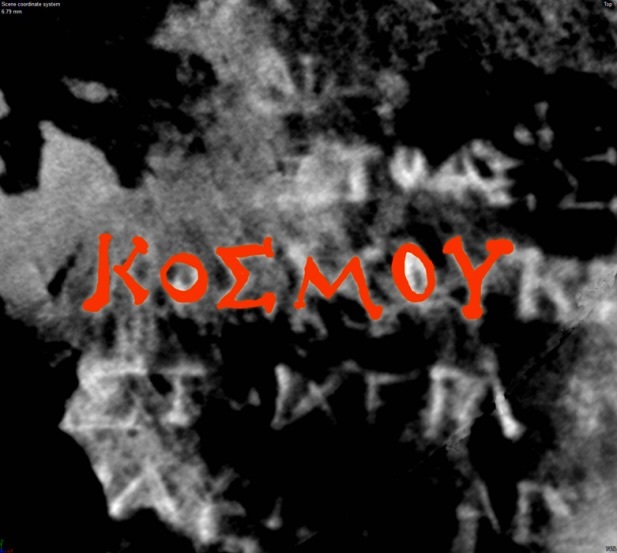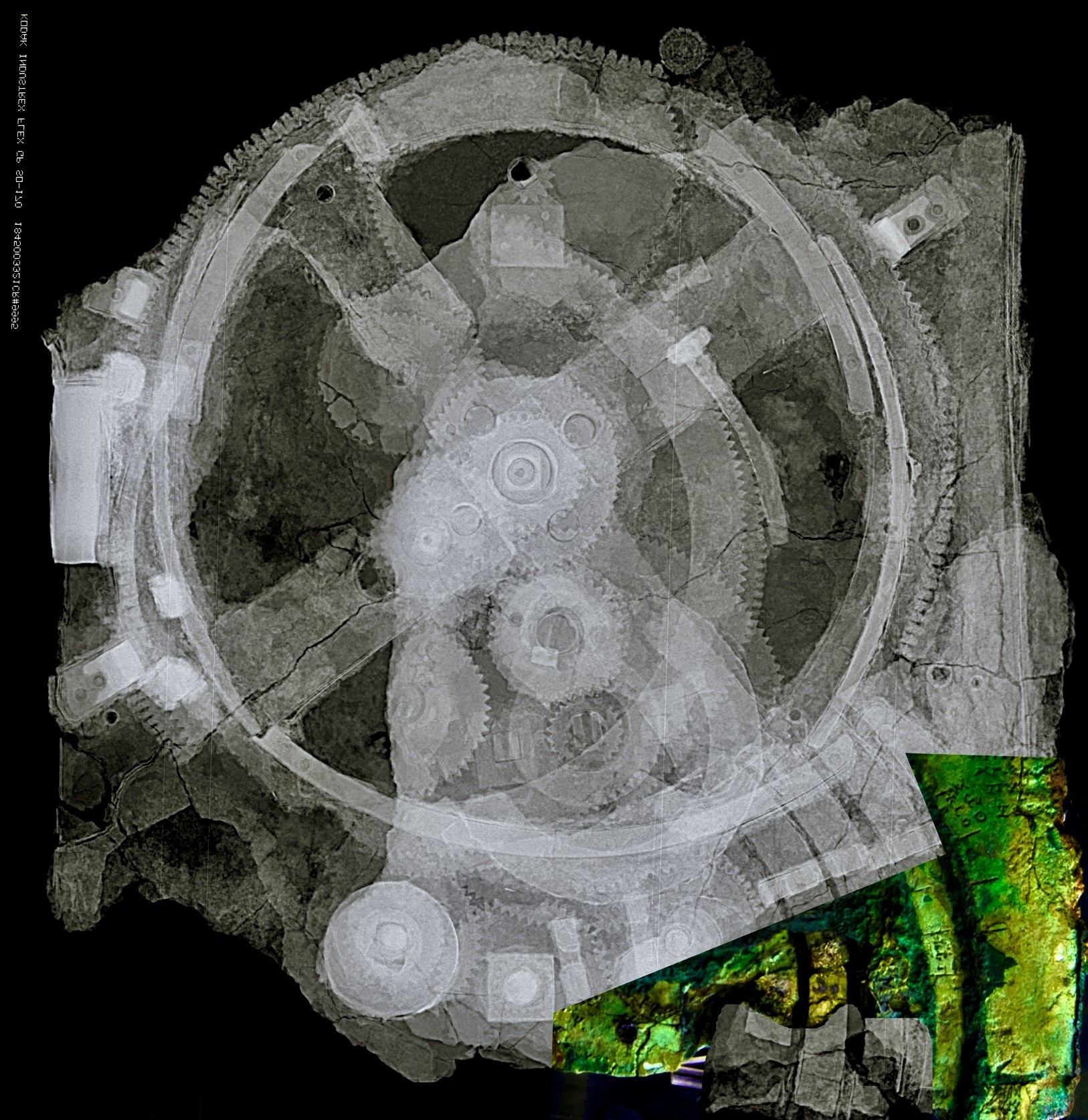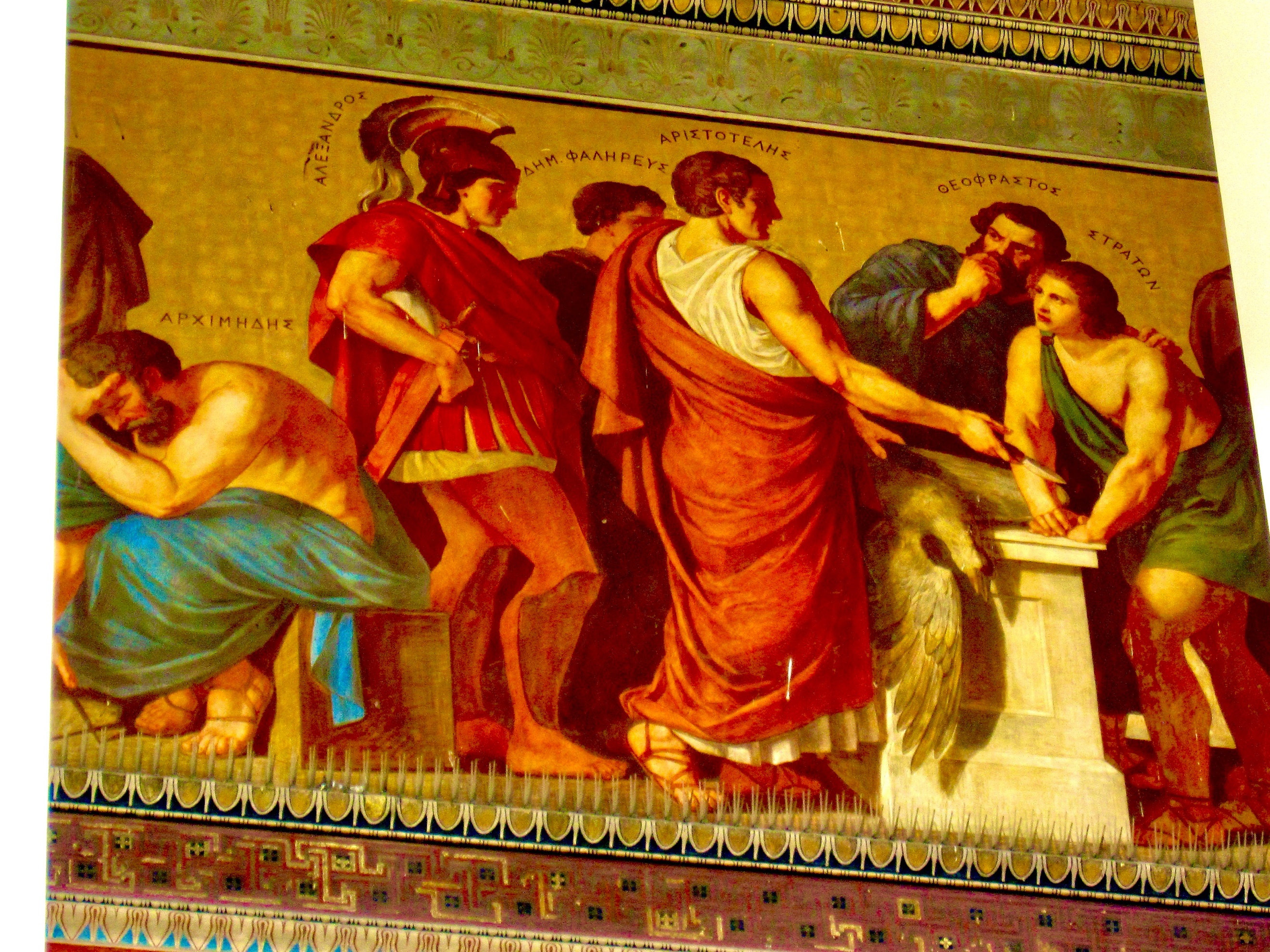
ΚΟΣΜΟΥ: Of the Cosmos. Back plate inscription, Antikythera Mechanism. X-ray Computed Tomography. Slice of Fragment B. Courtesy X-Tek Systems (Nikon Metrology)
Prologue
In its November 2023 issue, the Website Grunge assumed that certain science questions “won’t be answered in the next 50 years.” One of those questions was about the Antikythera Mechanism. The writer, Mikael Angelo Francisco, asked: “Why was the Antikythera Mechanism so ahead of its time?”
It won’t take 50 years to answer this question. I already answered it in my book, Antikythera Mechanism: The Story Behind the Genius of the Greek Computer and its Demise.
Overview
In the spring of 1900, Greek sponge divers in the Aegean Sea were caught in a storm that pushed their boat to the shore of Antikythera, a tiny island between Crete and Peloponnesos. Once the storm died down, a sponge diver went in search for sponges. But at the depth of about 50 meters he discovered a sunken ship full of ancient Greek treasures, including a stone-like artifact that, in time, turned out to be the device archaeologists baptized the Antikythera Mechanism.
For close to half a century, scientists did not have a clue about that strange device with nearly microscopic Greek inscriptions all over its bronze body and intricate and interlocking mechanical gears. The name, Antikythera Mechanism, was proof of the scientists’ uncertainty and confusion. Antikythera designated the place of discovery and mechanism that it was some kind of a machine. But even more astonishing was the scientists’ metaphysical rejection of the nature of the Greek toothed geared device. The presence of bronze toothed gears should have immediately convinced the observing scientists that the astronomical computer in front of them was a product of advanced technology. But that fact went against the wrong preconceptions scientists had about the ancient Greeks and about themselves. Their Christian metaphysics made it difficult to accept that ancient Greeks had developed a superior civilization that included advanced astronomical knowledge, advanced mathematics, and metallurgy. They were under the delusion those gifts of science and technology embedded in the Antikythera Mechanism were products of modern Christian civilization.
Why was the Antikythera Mechanism so far ahead of its time?
Only a German philologist, Albert Rehm, 1871-1949, approached the truth when he suggested, in 1907, that the Antikythera computer resembled the mechanical universe of Archimedes, Greek scholar-scientist-astronomer-mathematician-engineer of the third century BCE. Cicero, Roman politician, and scholar of the first century BCE, learned about the planetarium of Archimedes from a friend he called Gallus: The planetarium or sphere reproduced the eclipses of the Sun and the Moon and the movements of the heavens, the Sun, and the Moon, including those of the planets one could follow with the naked eye: Aphrodite (Venus), Hermes (Mercury), Ares (Mars), Kronos (Saturn), and Zeus (Jupiter). According to Cicero, the same eclipse of the Sun happened on the Archimedes Sphere as would actually happen in the sky. Cicero was certain that “there was more genius in that Sicilian [Archimedes] than human nature seems able to encompass.”[1]
In 212 BCE, the Romans assassinated Archimedes because his weapons had caused havoc among the invading Roman troops. Marcellus, the Roman general who captured Syracuse, looted the Greek polis and, among the spoils, he brought to Rome the Sphere of Archimedes.
The next step in understanding why the Antikythera astronomical computer was so ahead of its time comes from the work of Derek de Solla Price, British physicist, and professor of the history of science at Yale. Price studied the Antikythera astronomical computer for several years. In 1959, he spoke of the “scientific technology” of the Antikythera computer, which the ancient Greeks most likely called the Tablet or Meteoroskopeion. “Nothing like this,” Price said, “is preserved elsewhere.” He likened the Antikythera Mechanism to the great astronomical cathedral clocks built in Europe during the Renaissance or to a “modern analogue computer.” He saw the Tablet / Meteoroskopeion as “the venerable progenitor of all our present plethora of scientific hardware.” “It is a bit frightening,” Price admitted, “to know that just before the fall of their great civilization the ancient Greeks had come so close to our age, not only in their thought, but also in their scientific technology.”[2] Arthur C. Clarke, the world-famous science fiction author, read Price’s article in the Scientific American about the Antikythera Mechanism and went to Athens in 1965 to see the ancient device. He had a letter of introduction and support from an admiral. He visited the National Archaeological Museum in Athens three times before the museum staff located the fragments of the Antikythera Mechanism. They kept those fragments in a simple cigar box. Clarke was disappointed that the Greeks were so careless with such a great treasure of their ancient achievements. Far more important than his annoyance with the Greek bureaucracy was Clarke’s reaction to the fragments of the mechanism. Like Price, he fell into deep thought. “Looking at this extraordinary relic is a most disturbing experience,” he wrote. “Few activities are more futile than ‘what if …’ type of speculation, yet the Antikythera mechanism positively compels such thinking. Though it is over two thousand years old, it represents a level [of achievement], which our technology did not reach until the eighteenth century…. If the insight of the Greeks had matched their ingenuity, the industrial revolution might have begun a thousand years before Columbus. By this time [1975] we would not merely be pottering around the moon; we would have reached the nearest stars.”[3]
True, but not because the Greeks “missed the breakthrough into experimental science.” The Greeks employed experimental science in stitching the computer together. The reason students of the Antikythera computer refuse to contemplate why it nearly disappeared comes straight from metaphysics and history. The Christians made the Greek industrial revolution impossible. In late fourth century, they burned the Library of Alexandria and, otherwise, during several centuries, they destroyed the talent, infrastructure, and culture of ancient Greece.
In 1971, Price came back to the Antikythera fragments. He read a report from the Oak Ridge National Laboratory in Tennessee about gamma rays revealing the insides of metals. He wrote to the director of the Tennessee lab who put him in touch with the Atomic Energy Commission in Athens. The AEC had a nuclear physicist, Charalambos Karakalos, who responded to Price’s request to X-ray the Antikythera fragments. In the summer of 1972, Karakalos took hundreds of pictures of the fragments. Using those images and dogged careful analysis of the device itself, Price took years to master its intricacies. His research convinced him that the Antikythera Mechanism was “one of the most important pieces of evidence for the understanding of ancient Greek science and technology.” He explained why: The complexity of its gear design demonstrates a more precise picture of the advanced level of Greco-Roman “mechanical proficiency” than that coming out of any of the surviving textual evidence. He found the Antikythera Mechanism was a “singular artifact…. The oldest existing relic of scientific technology, and the only complicated mechanical device we have from antiquity. [It] changes our ideas about the Greeks and makes visible a more continuous historical evolution of one of the most important main lines [of Greek science and technology] that lead to our civilization,” he wrote.[4]

X-ray of the back side of Fragment A showing its interlocking gears. Courtesy X-Tek Systems (Nikon Metrology), the Antikythera Mechanism Research Project, and Aristeides Voulgaris who modified the image. Fragment A has 27 of the 30 surviving gears of the Antikythera computer. The size of the teeth is about 1 mm.
The achievement Price discovered in the fragments of the Meteoroskopeion illustrates the golden age of Greek science. This was an age that started with Aristotle and Prince Alexander of Macedonia, teacher, and pupil. Aristotle, philosopher, and inventor of science filled the head of young Alexander with political and scientific ideas of how to create a commonwealth of science, political virtue, and civilization.

Archimedes, left, Aristotle, middle, and his students (Alexander the Great, in military uniform, Demetrios Phalereus, between Alexander and Aristotle, Theophrastos and Straton, far right). Mural above the entrance of the University of Athens. Aristotle is giving the knife to Straton to dissect the bird. Photo: Evaggelos Vallianatos
Alexander conquered Persia and became Alexander the Great. He and his generals put Aristotle’s plan into action, especially in Alexandria, Egypt. Alexandria became a metropolis of scientific research employing the best minds of the Greek world. The Antikythera Mechanism / Meteoroskopeion came out of that climate of affluence, science, wisdom, and politics of moderation. The Mouseion-University and the great Library of Alexandria provided the ideal conditions for science and the public good.
The Antikythera Mechanism / Meteoroskopeion was a masterpiece of mechanical engineering. It united the heavens and Earth. The front plate of the device was the Cosmos with the Sun being at its very center. Two gears, one over the other, and with an ingenious pin-and-slot mechanism, enabled the astronomical computer to reproduce the elliptical trajectory of the Moon around the Earth. Pointers mapped the position of the planets, the phases of the Moon, and major constellations in the sky. The back plate had two spirals. The top larger spiral represented the 19-year 235 months Metonic calendar. And the lower spiral was the 18-year 223 month Saros predictive dial. It predicted the eclipses of the Sun god Helios and Selene / Moon. The predictions included the Olympics and other Panhellenic games. The entire astronomical device was about a foot long and a few inches wide. More than 30 bronze gearwheels directed the dials and pointers. About 27 of the gears were withing Fragment A of the Cosmos. A handle brought that Cosmos into motion.
Epilogue
The Antikythera Mechanism / Meteoroskopeion was probably constructed in Rhodes in the second century BCE. Hipparchos, the greatest astronomer of ancient Greece, supervised its creation modeled after the Sphere / mechanical universe of Archimedes. It was the second Parthenon, this one made of science and technology and astronomy, predicting the Olympics and the will of the gods – Sun god Helios and Selene / the Moon. It also offered the Greeks an accurate calendar and a practical means of exploring the Cosmos. Without doubt, the Antikythera machine was the greatest achievement of ancient Greece. The Antikythera Mechanism / Meteoroskopeion was a Pharos / Lighthouse illuminating the science and virtues of Greek civilization. It helped the Greeks to see and enjoy the new world that scientific achievements made possible. It still has the seeds of how to construct a better computer that would bring people together and focus their attention on the public good.
NOTES
1. Cicero, The Republic I.14.21–22, tr. Clinton Walker Keyes (Loeb, 1928). ↑
2. Derek de Solla Price, “An Ancient Greek Computer,” Scientific American, 200 (6) (1959) 60–67. ↑
3. Arthur C. Clarke, “Technology and the Limits of Knowledge,” in The Frontiers of Knowledge, ed., Brooke Hindle (Garden City, New York: Doubleday, 1975) 120–121. ↑
4. Derek de Solla Price, “Gears from the Greeks: The Antikythera Mechanism – A Calendar Computer from ca. 80 B.C.” in Transactions of the American Philosophical Society, 1974, 64 (7) 13. ↑
The post Why Was the Antikythera Mechanism So Far Ahead of its Time? appeared first on CounterPunch.org.
This post was originally published on CounterPunch.org.